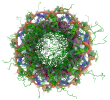Fit of model(s) to crosslinking-MS data
Restraint types
Restraint types are summarized in the table below. Restraints assigned "by-residue" are interpreted as between CA atoms. Restraints between coarse-grained beads are indicated as "coarse-grained". Restraint group represents a set of crosslinking restraints applied collectively in the modeling.
There are 151 crosslinking restraints combined in 151 restraint groups.
| Linker | Residue 1 | Atom 1 | Residue 2 | Atom 2 | Restraint type | Distance, Å | Count |
|---|---|---|---|---|---|---|---|
| L-Photo-Leucine | LEU | CA | TYR | CA | upper bound | 10.0 | 11 |
| L-Photo-Leucine | GLU | CA | LEU | CA | upper bound | 10.0 | 11 |
| L-Photo-Leucine | LEU | CA | VAL | CA | upper bound | 10.0 | 17 |
| L-Photo-Leucine | GLY | CA | LEU | CA | upper bound | 10.0 | 15 |
| L-Photo-Leucine | ASP | CA | LEU | CA | upper bound | 10.0 | 21 |
| L-Photo-Leucine | LEU | CA | THR | CA | upper bound | 10.0 | 8 |
| L-Photo-Leucine | ALA | CA | LEU | CA | upper bound | 10.0 | 20 |
| L-Photo-Leucine | ILE | CA | LEU | CA | upper bound | 10.0 | 9 |
| L-Photo-Leucine | LEU | CA | LYS | CA | upper bound | 10.0 | 3 |
| L-Photo-Leucine | CYS | CA | LEU | CA | upper bound | 10.0 | 3 |
| L-Photo-Leucine | ARG | CA | LEU | CA | upper bound | 10.0 | 3 |
| L-Photo-Leucine | LEU | CA | SER | CA | upper bound | 10.0 | 5 |
| L-Photo-Leucine | LEU | CA | PRO | CA | upper bound | 10.0 | 7 |
| L-Photo-Leucine | LEU | CA | LEU | CA | upper bound | 10.0 | 6 |
| L-Photo-Leucine | GLN | CA | LEU | CA | upper bound | 10.0 | 5 |
| L-Photo-Leucine | HIS | CA | LEU | CA | upper bound | 10.0 | 1 |
| L-Photo-Leucine | ASN | CA | LEU | CA | upper bound | 10.0 | 4 |
| L-Photo-Leucine | LEU | CA | MET | CA | upper bound | 10.0 | 2 |
Distograms of individual restraints
Restraints with identical thresholds are grouped into one plot. Only the best distance per restraint per model group/ensemble is plotted. Inter- and intramolecular (including self-links) restraints are also grouped into one plot. Distance for a restraint between coarse-grained beads is calculated as a minimal distance between shells; if beads intersect, the distance will be reported as 0.0. A bead with the highest available resolution for a given residue is used for the assessment.
Satisfaction of restraints
Satisfaction of restraints is calculated on a restraint group (a set of crosslinking restraints applied collectively in the modeling) level. Satisfaction of a restraint group depends on satisfaction of individual restraints in the group and the conditionality (all/any). A restraint group is considered satisfied, if the condition was met in at least one model of the model group/ensemble. The number of measured restraints can be smaller than the total number of restraint groups if crosslinks involve non-modeled residues. Only deposited models are used for validation right now.
| State group | State | Model group | # of Deposited models/Total | Restraint group type | Satisfied (%) | Violated (%) | Count (Total=151) |
|---|---|---|---|---|---|---|---|
| 1 | 1 | 1 | 10/10 | All | 50.33 | 49.67 | 151 |
| Self-links/ Intramolecular |
50.33 | 49.67 | 151 |
Per-model satisfaction rates in model groups/ensembles
Every point represents one model in a model group/ensemble. Where possible, boxplots with quartile marks are also plotted.
